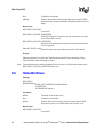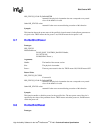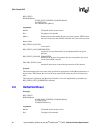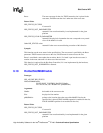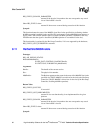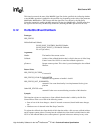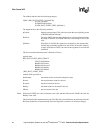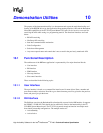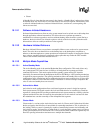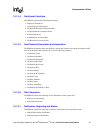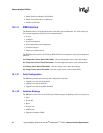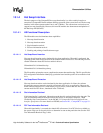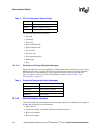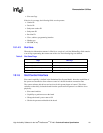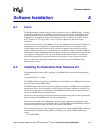
96 High Availability Software for the Intel
®
NetStructure
TM
ZT 4901 Technical Product Specification
Demonstration Utilities
• Cluster
A Standby Host is a host that does not control a bus domain. A Standby Host is referred to as being
in Standby mode. An Active Host is a host that owns at least one bus segment. Functionality such
as software initiated handovers, hardware initiated failovers, switchovers, event reporting and
alarms are exercised.
10.1.2.1 Software Initiated Handovers
Software initiated handovers allow an active system master board to switch over to the backup host
through application software intervention. This allows the user to perform preventative
maintenance or software upgrades to one host without shutting down the entire system. During a
handover, the device drivers are allowed to quiesce activity to the devices and synchronize state
information to allow an orderly transition of a bus segment.
10.1.2.2 Hardware Initiated Failovers
Hardware initiated failovers occur when a catastrophic failure occurs on the active system master
board. The active host can then failover to the backup host or the backup host can perform a
takeover so that interruptions to system operation are minimized. Examples of catastrophic failures
are a software watchdog timeout or a detected voltage spike that may render the CPU unstable.
These events warrant a hardware-initiated failover.
10.1.2.3 Multiple Mode Capabilities
10.1.2.3.1 Active/Standby Mode
The Active/Standby mode is the standard Redundant Host configuration. This mode allows only
one system master CPU board to have visibility to all backplane bus segments and all the
connected PCI devices. This mode requires that the standby system master CPU board be
electrically disconnected from the backplane at the PCI-to-PCI Bridge. A PCI spoofing mechanism
is required for proper operation. The spoofing mechanism allows the standby host to access the PCI
configuration space of backplane devices without having direct access to the devices. If a host fails
and requires a takeover, one of the hosts initiates a handover or failover and upon completion the
roles of active and standby hosts are reversed.
10.1.2.3.2 Active/Active Mode
Active/Active mode configuration allows each board segment to control a single bus segment.
Each system master CPU board controls the clock and arbitration for its controlled or owned bus
segment. It is through the PCI spoofing mechanism that each system master has visibility to the bus
segment and the devices that are owned by the redundant host. In this mode if one host fails then
the redundant host can take ownership of the relinquished bus segment.
10.1.2.3.3 Cluster Mode
Cluster mode is a variant on the Active/Active host mode. In Cluster mode if either host fails then
the bus assigned to the failed host is unavailable for ownership transference. This is referred to as
bus locking. While a system is dynamically capable of transitioning between Active/Standby and
Active/Active modes, and even into a Cluster mode, it is only through a system power cycle that a
system can transition out of Cluster mode. This is due to the fact that a locked bus segment may not
have PCI spoofing information consistent across multiple host domains.



